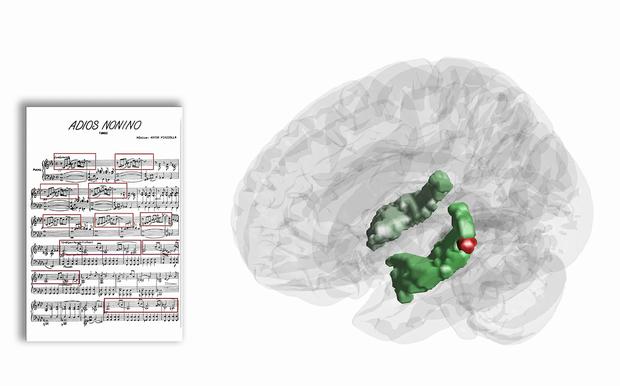A new study has found that the hippocampus, a brain structure crucial for creating long-lasting memories, is more active in response to recurring musical phrases while listening to music. That means hippocampal involvement in long-term memory may be less specific than previously thought and that short and long-term memory processes may depend on each other after all.
A fundamental highlight of the study by the University of Jyväskylä and the AMI Center of Aalto University is the use of a setting that is more natural than those traditionally employed in neuroscience: the participants’ only task was to attentively listen to an Argentinian tango from beginning to end. This kind of music provides well-defined, salient musical motifs that are easy to follow. They can be used to study recognition processes in the brain without having to resort to sound created in a lab. By using this approach, the researchers say they were able to identify brain areas involved in motif tracking without having to rely on the participants’ ability to self-report, which would have constrained the study of brain processes.

Activity in an area (in red) within the hippocampus (in green) increased when musical motifs in the piece were repeated. Courtesy of Suomen Akatemia (Academy of Finland).
“Our study basically shows an increase of activity in the medial temporal lobe areas—best known for being essential for long term memory—when musical motifs in the piece were repeated. This means that the lobe areas are engaged in the short-term recognition of musical phrases,” explains Iballa Burunat, the leading author of the study.
Dr. Elvira Brattico, Aalto University added, “Importantly, this hadn’t been observed before in music neuroscience.”
Burunat went on to explain ,“We think that our novel method allowed us to uncover this phenomenon. In other words, the identified areas may also be related to the formation of a more permanent memory trace of a musical piece, enabled precisely by the very use of a real-life stimulus (the recording of a live performance) in a realistic situation where participants just listen to the music as their brain responses are recorded."
Listening to the music from beginning to end may have imprinted the participants with a long lasting memory of the tune. This might not be expected were the participants exposed to a simpler stimulus in controlled conditions, as is the case in most studies in music and memory.
Although a real-life setting may be sufficient to trigger the involvement of the hippocampus, another explanation could lie in music’s capacity to elicit emotions. “We cannot ignore music’s emotional power which is thought to be crucial for the mnemonic power of music as to how and what we remember. There is evidence on the robust integration of music, memory and emotion—take for instance autobiographical memories. So it wouldn’t be surprising that the emotional content of the music may well have been a factor in triggering these limbic responses,” she continues. This makes sense, since the chosen musical piece by Astor Piazzolla was a tribute to his father after his sudden death, and so the main purpose of the piece was to be of a deeply emotional nature”.
Certainly, the hippocampus—as part of the limbic system—is connected to neural circuitry involved in emotional behavior, and ongoing research suggests that emotional events seem to be more memorable than neutral ones. The authors emphasize that these results should motivate similar approaches to study verbal or visual short term memory by tracking the themes or repetitive structures of a given stimulus.
Moreover, they believe the study has implications for neurodegenerative diseases associated with hippocampal atrophy, like Alzheimer’s.
“Music may positively affect patients if used wisely to stimulate their hippocampi, and thus their memory system,” Academy Professor Petri Toiviainen indicates. A better understanding of the link between music and memory could have widespread repercussions, leading to novel interventions to rehabilitate or improve the life quality of patients with neurodegenerative conditions.
Citation: Burunat, I., Alluri, V., Toiviainen, P., Numminen, J.,&Brattico, E. (2014). Dynamics of brain activity underlying working memory for music in a naturalistic condition, Cortex, doi:10.1016/j.cortex.2014.04.012





Comments